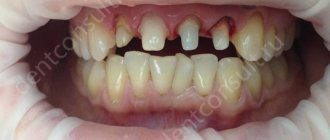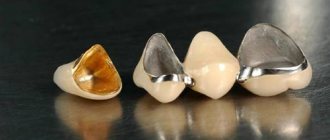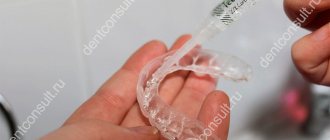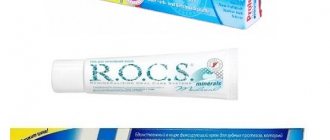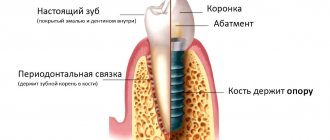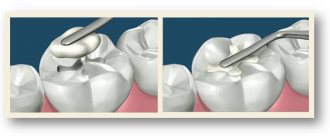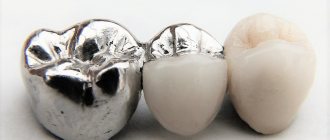Content
hide
1 What are dentures made of?
2 Materials for dentures, their types and features, strengths and weaknesses. 2.1 - Composite
2.2 - Ceramics
2.3 - Metal ceramics
2.4 - Oxide, zirconium dioxide
2.5 - Metal alloys
2.6 - Plastic (acrylic, nylon)
3 Which material is better for prosthetics?
Dentures are a way to replace destroyed dental tissues, restore the usual volume of the jaw, its aesthetic and functional parameters. Loss of teeth leads to consequences such as distortion of speech, decreased quality of digestion, and degenerative processes in bone tissue, which are associated with a decrease in mechanical load on certain areas of the jaw. There are a large number of modern materials that are used in dentistry for prosthetics. How to choose dentures and not get confused in a wide range of materials? More expensive options do not always have a significant advantage for a specific clinical situation - each prosthesis has its own characteristics.
What are dentures made from?
Modern dental prostheses differ from each other in aesthetic and functional parameters. Today, dentists use materials that are safe for the body and convenient to work with, with the help of which they can achieve the effect necessary for the patient and his health:
- composite;
- ceramics;
- metal ceramics;
- oxide, zirconium dioxide;
- metal alloys;
- plastic (acrylic, nylon).
When are temporary crowns used?
The installation of such orthodontic structures is recommended by the dentist in the following cases:
- minor defect in the dentition. Installing a temporary crown will help eliminate the unhealthy color of the element or its irregular shape in order to maintain the normal appearance of the dentition,
- waiting for the production of a permanent prosthesis,
- preventing infection of dental tissues after grinding and displacement of adjacent elements,
- exclusion of fusion of the gum bed, if the patient has not decided on the choice of further type of treatment,
- installation of a splint for periodontal disease. A plastic crown normalizes problems with diction,
- creating support elements to hold removable products in order to properly distribute the chewing load,
- violation of tooth integrity more than 50%.
It is worth remembering that the following contraindications exist:
- age up to 12 years,
- bite too deep
- presence of bruxism,
- inflammation of the gum or tooth tissue at the installation site,
- allergic reaction to plastic,
- neurological and mental disorders.
Plastic is highly porous, so if you are not particularly careful about hygienic oral care, you should avoid installing this type of structure.
Materials for dentures, their types and features, strengths and weaknesses.
— Composite
A composite is a polymer compound that may contain various additives. Typically, the composite contains quartz, silicon, porcelain dust and other options. Exposure of the composite to ultraviolet light makes it stronger and more durable. At first, composite was not as hard and was used more to replace front teeth, which are not as involved in the chewing process. However, modern changes that have affected the material allow it to be used more widely for prosthetics.
Composite materials are applied in layers, they are alternately applied to the extended tooth, and then irradiated with ultraviolet light and given the required size and shape. The doctor chooses a shade that matches the color of the patient’s teeth as closely as possible. Composites have a relatively low price and are stronger than plastic structures. Over time, they may fade, change color and may require replacement, which should be taken into account when choosing the type of prosthetics.
— Ceramics
This is a fairly popular material for dental prosthetics, because it has a number of advantages. Ceramic prostheses do not cause reactions from soft and bone tissues and have a high level of hygiene. The prosthesis is strong and durable and can withstand loads well. Ceramics is a material that easily meets the patient’s aesthetic needs and allows one to hide dental defects. The finished prosthesis is light and does not put pressure on the jaw, this is important for large-scale prosthetics, because then the weight of each element plays a role.
ledent.ru
Many are stopped by the price of the issue, but the cost of a ceramic prosthesis is justified by its quality, which is confirmed by long-term work with patients and assessment of the condition of the jaw after using ceramics.
— Metal ceramics
Partial dental prosthetics and restoration of chewing elements are the most common field for the use of reinforced ceramic prostheses. They are based on a metal structure, which makes the final version more durable and prolongs its operation. Metal-ceramic dentures are of high quality at an affordable price, as well as an aesthetic appearance. This is the reason for the popularity of such designs.
They are used to replace severely damaged teeth, restore pulpless elements, and replace previous dentures that have worn out. Metal ceramics are used even in cases of pathological abrasion of teeth, which is a contraindication for the use of some other materials.
The advantage of the method is the possibility of widespread use of metal-ceramic prostheses - they allow you to restore several teeth, they are used in bridge structures, when the functional and anatomical parameters of the teeth are violated. Another advantage is the strength and long service life of structures. Metal-ceramics are preferred by patients and dentists for their beautiful appearance, versatility, reasonable cost and reliability.
Of the minuses, it is worth noting the fact that over time a metallic tint may appear along the edge of the gum, in the place where it is adjacent to the prosthesis. In some patients, metal cannot be used due to allergies. If gum recession occurs, the metal component of the structures may be visible from the outside.
— Oxide, zirconium dioxide
One of the most popular modern materials - it meets all the necessary requirements for prostheses. Crowns made from it have high aesthetics; it is possible to choose a color identical to the shade of the patient’s enamel. Zirconium structures are used to replace front, chewing teeth of different locations, because they are as strong and reliable as they are aesthetic. They can be used to form a bridge. The zirconium-based structure will last for several decades or more - just careful treatment and standard procedures for caring for the prosthesis.
The cost of zirconium prostheses may seem high - this is explained by the need for special technical equipment to form the structure. This is not surprising, because the material is really durable, not only in use, but also for the work of the technician. This price justifies the quality and durability of use. Cheaper materials are accompanied by a uniform decrease in service life and worse aesthetics.
— Metal alloys
Metal structures are certainly durable and strong; they do not change their position and appearance over the years. Basically, metals are used to replace lateral teeth, since the aesthetic parameters are low. Among the disadvantages, it is also worth noting the possibility of an allergic reaction. Metal can harm adjacent and contralateral teeth, because the alloy is much stronger than native enamel.
Crowns are made from alloys - these can be various compounds of chromium, cobalt, and nickel. The prosthesis performs its function well, but is not suitable for everyone. By the way, metal can affect and change the taste. Noble metals do not harm the body, are quite durable and have an appropriate price. We are talking about combinations of gold, platinum, palladium. Modern technology makes it possible to cast structures that ideally replace the loss and ensure a good fit of the prosthesis.
— Plastic (acrylic, nylon)
Used to form a removable denture. Acrylic has a lower cost, but this fact is accompanied by a number of disadvantages - acrylic absorbs odors well, which can cause discomfort, the material is stained and changes shade under the influence of tea, coffee and other food colorings. Plastic has a porous structure, which is a positive condition for the growth of bacteria. Such structures require careful maintenance, which will extend their service life and quality of use.
Nylon has the best performance for prosthetics. Structures made from it are light and flexible, resistant to deformation. They tolerate moisture well, are resistant to microbes and are safe for health. The aesthetic side is also a strong point of nylon prostheses - they are translucent and have discreet fasteners.
How are they attached?
Several fixation methods are used for dentures.
On the closing valve. It is often called a “suction cup”; it is an element of the base, the basis of the structure, which in shape must exactly match the gum. When the denture is placed and bitten, air escapes from the gap between it and the mucous membrane. When completely sealed, a sealed space is formed, and the base is held as if on a suction cup. For more reliable fixation of a complete denture with a closing valve, special gels can be used.
On clasps. This fastening is used for conditionally removable, partial structures; they are mainly made of acrylic. Fixation is performed using metal hooks that are placed on the remaining teeth. Usually these are the incisors in the smile area, and therefore the clasps can be visible. Fixation is reliable, without the risk of displacement or accidental loss, the chewing load is distributed better than when using a locking valve.
On elastic clasps. They are used for structures made of nylon, made of plastic, pink in color, and invisible. Fastening is almost the same as when using metal hooks, but elastic clasps are more convenient, less damaging to the mucous membranes, and easier to get used to.
On attachments. These are composite micro-locks that can be used if the patient has preserved at least part of the dentition. One of the attachment elements is built into the base, the other is fixed to the supporting tooth and covered with a crown. The fixation is reliable, durable, the entire structure is protected from displacement, and transfers the chewing load well. Attachments are used with clasp dentures (having a metal base).
What is the best material for prosthetics?
The choice of materials for prosthetics is quite large. There is no clear answer to the question of choosing a prosthesis. It is best to answer this question from your attending physician. When selecting materials for the formation of a prosthesis, the dentist takes into account the individual characteristics of the patient, his anatomical data, the need for aesthetics, and capabilities. Options that are incompatible with local tissues and may cause a reaction or cause harm are immediately eliminated.
You also need to focus on what is most important to you - durability, price, aesthetics. A specialist will help you sort out this issue and choose the best option that will satisfy your basic needs and give good performance.
How to care for removable dentures?
The most important rule is good oral hygiene, and then there is no risk of damage to the denture or inflammatory processes in the oral cavity. Caring for dentures is simple and does not take much time:
- Brush with a toothbrush at least 2 times a day.
- Wash with warm water (no more than 40 degrees).
- Dry on a soft-lint towel; it is advisable not to blot or wipe, so as not to put pressure on the base of the prosthesis.
- Disinfect twice a day with a special product. In some cases, you can soak the denture in a disinfectant overnight.
- Once every six months – preventive cleaning of the prosthesis.
Technicians' work
This manufacturing stage largely replicates the steps of the clinical process, since they are closely interrelated.
How dentures are made by technicians:
- Making a cast from plaster.
- Making an individual impression tray based on a plaster cast.
- Production of diagnostic and working models.
- Creating a duplicate of the working model.
- Plastering of the working and auxiliary models in the articulation.
- Placement of crowns on a wax base and filling with plastic.
- Replacing the wax with a polymer base.
- Assembly, polishing and grinding of the finished product.
- Sending the finished product to the orthodontist.
Care
Basic care rules to ensure the long life of an orthodontic product:
- twice daily cleansing of the oral cavity with a soft brush and paste. In this case, the installation site of the crown must be treated with special care,
- rinsing your mouth after eating,
- use dental floss, irrigators or brushes to remove food grains from the interdental space,
- try not to touch the teeth of the upper and lower jaw too tightly,
- Do not eat viscous or too hard foods, especially avoid biting them. When taking them, the chewing load must be shifted to the other side,
- If the product is chipped or broken, contact your dentist as soon as possible.
What types of plastic are used?
Self-hardening plastics have gained great popularity in dentistry for the manufacture of temporary crowns due to their rapid hardening at room temperature. They are also capable of freezing at the temperature of the human body. This greatly simplifies the process of manufacturing temporary structures and reduces its time.
Polymerization occurs due to the initiating effect of the initiator-activator system, in which the first component is benzoyl peroxide, and the second is demethylparatoluidine.
The following types of fast-hardening cold polymerization plastics are used:
- Protacryl. It is a pink powder containing benzoyl peroxide, polymethyl methacrylate and disulfanamine. The presence of two activators allows the hardening process to reach the final result in 15-20 minutes,
- Redont. Available as a translucent pink powder and liquid,
- Stadont, powder-liquid acrylic plastic. The Stadont kit includes 3 types of powder in different colors,
- Acrylic oxide is a white plastic made from acrylic and epoxy resin. The set includes 3 powders and a liquid,
- Carboplast. It contains chalk. In dough-like form, it is distributed over the plaster model in an even layer and quickly hardens while on it.
Unlike hot-curing plastics, these types do not require heating equipment, and the size of the resulting product undergoes fewer changes. Their disadvantage is their low strength compared to hot-curing plastics.
Which dentures are better: nylon or acrylic?
Having decided to get dentures, many people ask the question: which removable dentures are best? Which material to choose: nylon or acrylic? There is no clear answer to this question. It all depends on your needs and individual characteristics. A lot also depends on your finances.
Nylon dentures are suitable for people with allergies, but acrylic ones are not the best option in this case. When trying on, pay attention to your own feelings. Prosthetic materials are perceived differently by each person. If the prosthesis causes discomfort when trying on, then when worn every day this can become a problem. Be careful and consult your doctor. This will help avoid discomfort when wearing.
From a financial point of view, acrylic structures are much more affordable than nylon ones. However, nylon ones are more comfortable to wear; acrylic ones are considered a temporary option before dental implantation.
Taking into account many aspects and the authoritative opinion of the dentist, you can choose the most suitable prosthetic option. Therefore, choosing the best removable denture is a purely individual matter.
Nylon dentures
When choosing a removable denture, your doctor will offer you several options for materials. It can be nylon, acrylic or silicone. Nylon is a durable and elastic material. Due to these properties, removable dentures made from this material are called “flexible”.
Nylon prostheses have a number of undeniable advantages:
- Hypoallergenic;
- Durable;
- Easy to use;
- The fastening is reliable;
- Does not require grinding of adjacent teeth or other painful procedures;
- Will not break diction;
- Suitable for people suffering from diabetes and heart disease;
- You can choose any crown material.
One of the biggest advantages of nylon backing is its long lifespan and ease of maintenance. You can clean nylon removable structures with regular soap and a brush. However, to extend the life of the dentures, you should still use special baths and pastes. Once every two to three months, it is advisable to take nylon dentures to the clinic so that they can be more thoroughly cleaned.
Another advantage is that any crowns can be selected for nylon removable structures, which means this technology is available to patients with different financial capabilities.
Materials for the manufacture of fixed dentures
At this stage, you cannot do without a visit to the dental office, where the orthodontist performs a set of activities:
- A thorough examination of the oral cavity and identification of existing problems;
- Patient visiting the X-ray room. The image will help the specialist determine the condition of the bone tissue and possibly identify gum abnormalities;
- Sanitation of the oral cavity – removal and treatment of remaining teeth, removal of tartar, whitening (at the request of the patient);
- Selection of the shade of the artificial crown, the option of the future prosthesis and material;
- Taking a plaster cast of the jaw, on the basis of which diagnostic and auxiliary prostheses are made;
- Assessment of jaw occlusion and identification of possible deviations using wax rollers;
- Drawing a drawing of the future prosthesis on a diagnostic model;
- Drawing the outline of the frame on the working model, based on the marks of the diagnostic model;
- Contour correction using a parallelometer;
- Trying on the prosthesis and eliminating possible defects;
- Final fitting of the finished product, explanation of the rules of operation and care.
